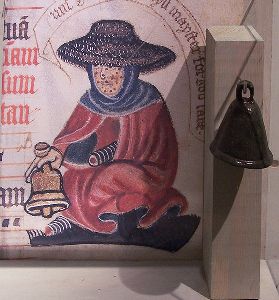By Regan Allen (Vanderbilt University)
In its later stages, the body of a medieval leper bore the appalling signs of decay and putrefaction: a misshapen face, numb and deteriorating limbs, festering sores on the skin, rancid breath and a raspy, fading voice. Believed to be highly contagious, this distressing image was the source of vast panic in medieval Europe. The progressing fear of leprosy in part justifies the existence of surprisingly extreme proposed treatments and cures during that time.
Medieval physicians explained leprosy’s unsightly symptoms by humoralism, a well-established medical model that divided bodily composition into four fluids, or humors: blood, yellow bile, black bile, and phlegm. Many asserted that an excess of black bile contaminating the blood resulted in the leprous condition. This conjecture resulted in a variety of treatments that aimed to purify the blood and the body as a way to realign the humors.
For example, an alchemist would give a leprous individual a concoction containing gold, a metal that symbolized richness and purity. Lepers willingly drank the solution expecting that the gold would cleanse and restore humoral equality, correcting the infirmity.
Lepers were also submitted to the evacuation of excess humoral fluid through regular bloodletting. Typically, a surgeon would cut a vein near the location of the accumulated corrupt blood. A regulated amount of fluid collected in a pan as it seeped out of a blood vessel, ideally eradicating large quantities of concentrated impurities.
The medieval practice of spilling pure blood through sacrifice constitutes another, more fantastical proposed treatment. Soaking in a bath medicated with the blood of an infant or a virgin was considered a possible cure. A leper who sat in this blood bath expected to undergo what would now be considered like a transfusion: the corrupt blood moves out of the body while the untainted blood moves in to replace it.
In today’s Western culture, leprosy exists more commonly as a literary metaphor than as an actual threat to general welfare. However, the same cannot be said for the Medieval Ages, in which leprosy’s extensive presence cultivated the development of treatments as extreme as the society’s overwhelming fear of the disease.
Brenner, Elma. “Recent Perspectives on Leprosy in Medieval Western Europe1.” History Compass 8.5 (2010): 388-406. Print.
Brody, Saul Nathaniel. The Disease of the Soul; Leprosy in Medieval Literature. Ithaca: Cornell UP, 1974. Print.
Demaitre, Luke E. Leprosy in Premodern Medicine: a Malady of the Whole Body. Baltimore: Johns Hopkins UP, 2007. Print.
Zimmerman, Susan. “Leprosy in the Medieval Imaginary.” Journal of Medieval and Early Modern Studies 38.3 (2008): 559-87. Print.

